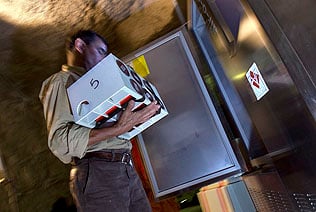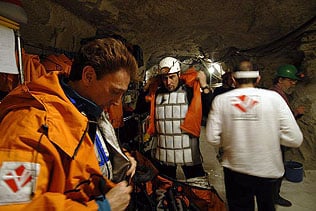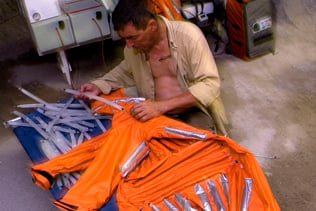|
Giuseppe Casagrande, a member of the La Venta group |
Tullio Bernabei and Franceso Lo Mastro |
To counteract the adverse conditions of the Crystals' Cave, several types of thermal insulation equipment have been developed. These are vests and suits lined with ice, and cold air respirators of various models according to the activity to be carried out; the product of experience and needs of the working teams. |
| Their use allows a stay in the cave’s interior for about one hour, making slow movements, trying not to spend much energy. To protect the body and breathe fresh air, the use of respirators is also necessary; hot air circulates through a spiral made of ice. The suits combined with the respirators, weigh approximately 22 kilos making the movements in the cave a complex procedure. The present model is the result of permanent adjustments. |
El equipo mexicano, aprovechando la iniciativa y experiencia, se dio a la tarea de adaptar a The Mexican team, taking advantage of La Venta’s initiative and experience, adapted to their special needs the same technical principles, designing a light short vest with small flat gel bags, which compared to the heavier model facilitated mobility within the cave and made the camera and lighting easier for the work of photography and film. They are manufactured with resistant low cost materials for daily use. Several smaller respirators have been tried and in this manner the team could stay in the cave for periods of 30 minutes. In this case the total weight is 8 kilos. |
|
|
Giuseppe Casagrande preparing the "Ptolomy" cold suit. | In any case, the time of stay in the cave is limited. It must be avoided at all costs to leave the cave without cold reserves in the suit and respirator. The very moment the ice melts, the body temperature rises rapidly and the effort required to return without reserves particularly while carrying equipment, increases the risks and limits physical resistance to dangerous levels. |




